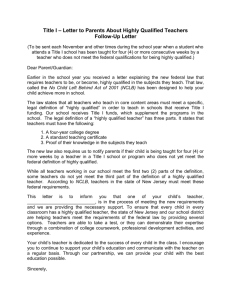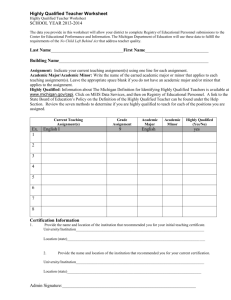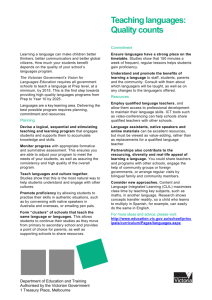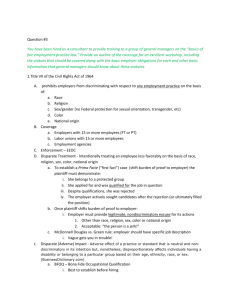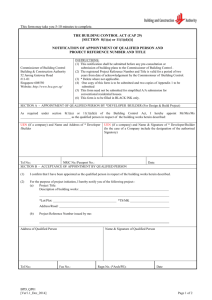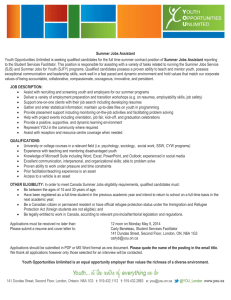Chapter 8: Installation, Administration and Termination of Qualified
advertisement
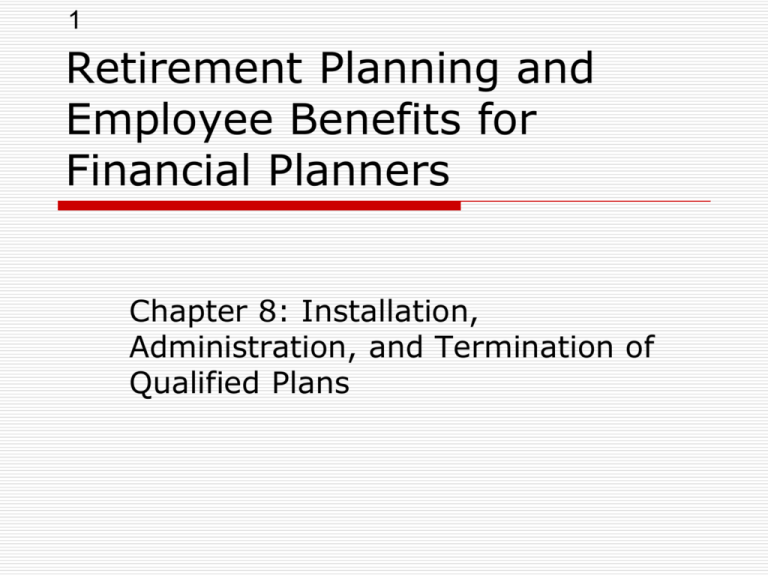
1 Retirement Planning and Employee Benefits for Financial Planners Chapter 8: Installation, Administration, and Termination of Qualified Plans 2 Introduction Overall Compensation Package Recruit Retain Selection Time-Consuming Expensive Establishment Requirements Filings © 2007 ME™ - Your Money Education Resource™ 3 Qualified Plan Selection Business Objectives (Exhibit 8.4 Page 353) Competitive Employment Tax-deferred Savings Employee Census Old vs. Young Level of compensation Peons vs. Top Dogs Turnover Length of service Cash Flow Considerations Administration Costs Owner’s Business and Personal Objectives © 2007 ME™ - Your Money Education Resource™ 4 Qualified Plan Selection Cash Flow Considerations Stable Pension Varies Profit sharing None 401(k) Administration Costs Defined benefit versus 401(k) versus ESOP Owner’s Business and Personal Objectives Maximize her benefits? Minimize peons? © 2007 ME™ - Your Money Education Resource™ 5 Establishing a Qualified Plan (1 of 2) Select and adopt appropriate plan: Must be in writing and adopted by the last day of the company’s tax year. Must be funded by the due date of the company’s tax return. Individually Designed Most Expensive Determination Letter Only means plan qualified if it does what it says it will © 2007 ME™ - Your Money Education Resource™ 6 Establishing a Qualified Plan (2 of 2) Master or Prototype Plan: Master – Single trust or account used by all adopting employers. Prototype – Each employer establishes their own separate trust or account. Cheap © 2007 ME™ - Your Money Education Resource™ 7 Initial Notification of Eligible Employees Who? Present employees who are eligible to participate in the plan, and Present employees who are not eligible to participate but are in the same location as those eligible to participate. How and When? In person or posting – 7 to 21 days before request to IRS. Mailed – 10 to 24 days before request to IRS. © 2007 ME™ - Your Money Education Resource™ Ongoing Notification of Eligible Employees 8 Summary Plan Description Employer must furnish to employee within 90 days after the employee becomes a participant, or Within 90 days after the employee receives a benefit from the plan, or Within 120 days after the plan is established. Summary of Material Modifications Employer must furnish to plan participants within 210 days after the end of the plan year in which an amendment is adopted. © 2007 ME™ - Your Money Education Resource™ 9 Qualified Trust Qualified plan assets must be placed in a qualified trust or custodial account. Generally maintained by a bank or other financial institution. Don’t commingle Do deposit quickly © 2007 ME™ - Your Money Education Resource™ 10 Investing Plan Assets Plan Sponsor Asset management firm hired by plan sponsor Usually, defined benefit plans Fiduciary: act in participants best interest Self-Directed Plan Participant Usually, defined contribution plans Sponsor must provide participants with a broad range of investment alternatives Provide diversification © 2007 ME™ - Your Money Education Resource™ 11 Qualified Plan Administration Operating the Plan Meeting coverage requirements Contributions Installments Quarterly: defined benefit plans In following year: if by date tax return is filed © 2007 ME™ - Your Money Education Resource™ 12 Deduction of Contribution Limited to 25% of overall employee covered compensation Self-Employed persons calculation (Keogh Plans) Self-Employment Income - ½ Self-Employment Tax =Adjusted S-E Income X 20% S-E Contribution Percent =Contribution Limit © 2007 ME™ - Your Money Education Resource™ 13 Excess Contributions Contributions in excess of permitted deductible amount. Subject to 10% excise tax penalty. Carryover amount to subsequent years. © 2007 ME™ - Your Money Education Resource™ 14 Forfeitures Defined Benefit Plans Forfeitures reduce employer plan funding costs. Defined Contribution Plans Forfeitures reduce employer plan funding costs, or Allocate forfeitures to accounts of remaining participants. © 2007 ME™ - Your Money Education Resource™ 15 Prohibited Transactions (1 of 3) Transactions between a qualified plan and a disqualified person that are prohibited by law. Disqualified Person Plan Fiduciary Service Providers Plan Sponsor Owners, partners of plan sponsor Family members of owners Officers and directors of plan sponsor © 2007 ME™ - Your Money Education Resource™ 16 Prohibited Transaction (2 of 3) Prohibited Transactions Transfer of plan income or assets to, or use of them by or for the benefit of a disqualified person. Self dealing by a fiduciary. Receipt of consideration by a fiduciary for his own account when dealing with a party in interest. Selling, exchanging, leasing, buying as well as lending or borrowing between a disqualified person and the plan. © 2007 ME™ - Your Money Education Resource™ 17 Prohibited Transactions (3 of 3) Penalty 15% of the amount involved per year. 100% if not corrected within the taxable year. Payable by disqualified person. Can be avoided by correcting the transaction as soon as possible. © 2007 ME™ - Your Money Education Resource™ 18 Employee Retirement Income Security Act (ERISA) Protects employee benefits. Anti-alienation: can’t lose them Imposes fiduciary responsibility on plan management. Care, skill, and diligence of a prudent person acting solely in the interest of plan participants and their beneficiaries. Obligation to diversify plan assets. Must act in accordance of plan document. Must refrain from acts forbidden by law. © 2007 ME™ - Your Money Education Resource™ 19 Department of Labor Enforces the rules governing the following: Plan managers. Plan investments. Reporting and disclosure of plan information. Enforcement of fiduciary provisions of the law. Workers’ benefits as regulated by ERISA. © 2007 ME™ - Your Money Education Resource™ 20 Pension Benefit Guaranty Corporation (PBGC) Guarantees Pension Benefits Defined Benefit Pension Plans Cash Balance Pension Plans 44 million participants As of 9/30/06, $60 billion of assets, $78 billion of liabilities Does not cover defined contribution plans, or plans of professional service corporations with 25 or fewer participants. Plan sponsor pays premiums of: $49 per plan participant, and Maximum annual PBGC benefit of $59,320 for 2014. No COLA © 2007 ME™ - Your Money Education Resource™ 21 Reporting Requirements Form 5500 Filed with Department of Labor. Due by the last day of the 7th month after the plan year end. See Exhibit 8.20 on page 388 for various schedules. Form 5500-EZ If the plan ONLY provides benefits for the employer, his spouse, or a partner of the employer. No filing requirement for a plan with one participant and plan assets of $100,000, or less. © 2007 ME™ - Your Money Education Resource™ 22 Amending or Terminating a Qualified Plan – Why? To maximize benefits for key employees. Law changes. Employer is unable to support plan contributions. Benefits provided to plan participants were not sufficient. © 2007 ME™ - Your Money Education Resource™ 23 Amending or Terminating a Qualified Plan – How? (1 of 3) Amending Amend the Plan Document Revise the Summary Plan Description Notify the Plan Participants Summary of Material Modifications © 2007 ME™ - Your Money Education Resource™ 24 Amending or Terminating a Qualified Plan – How? (2 of 3) Terminating All participants become fully vested. Plan must not have been established as a temporary program. Defined Benefit Plans Standard Voluntary: plan has assets to pay all benefits Distress: unable to continue plan due to financial distress/bankruptcy Involuntary: PBGC takes over to limit exposure © 2007 ME™ - Your Money Education Resource™ 25 Amending or Terminating a Qualified Plan – How? (2 of 3) Terminating All participants become fully vested. Plan must not have been established as a temporary program. Defined Benefit Plans Standard, Distress, Involuntary Defined Contribution Plans Terminate contributions after fulfilling all contribution requirements. © 2007 ME™ - Your Money Education Resource™ 26 Amending or Terminating a Qualified Plan – How? (3 of 3) Plan Freeze Defined contribution Plan sponsor no longer makes contributions to the plan. Defined benefit Participants can’t accrue additional benefits Participants must still meet vesting requirements. © 2007 ME™ - Your Money Education Resource™
